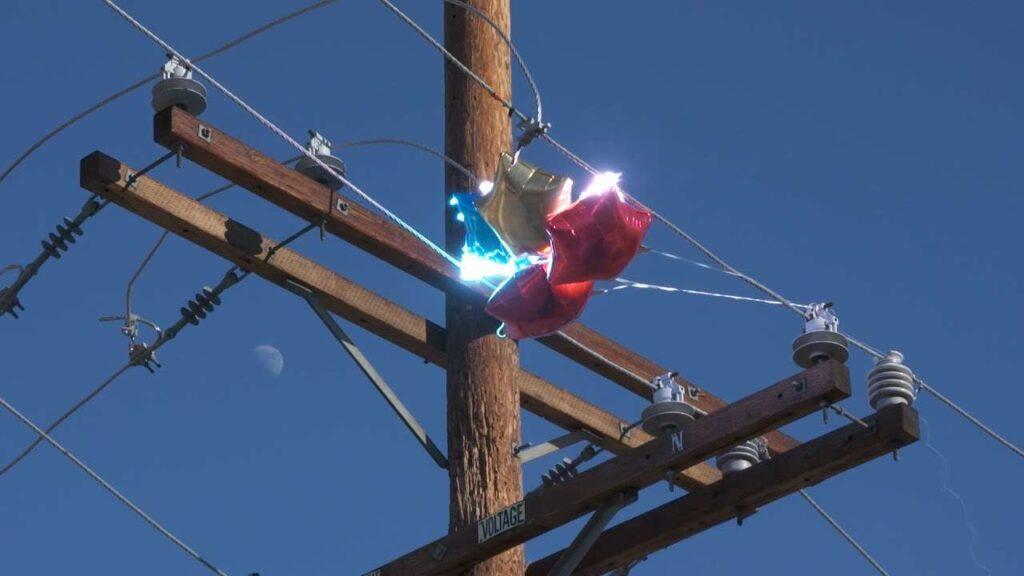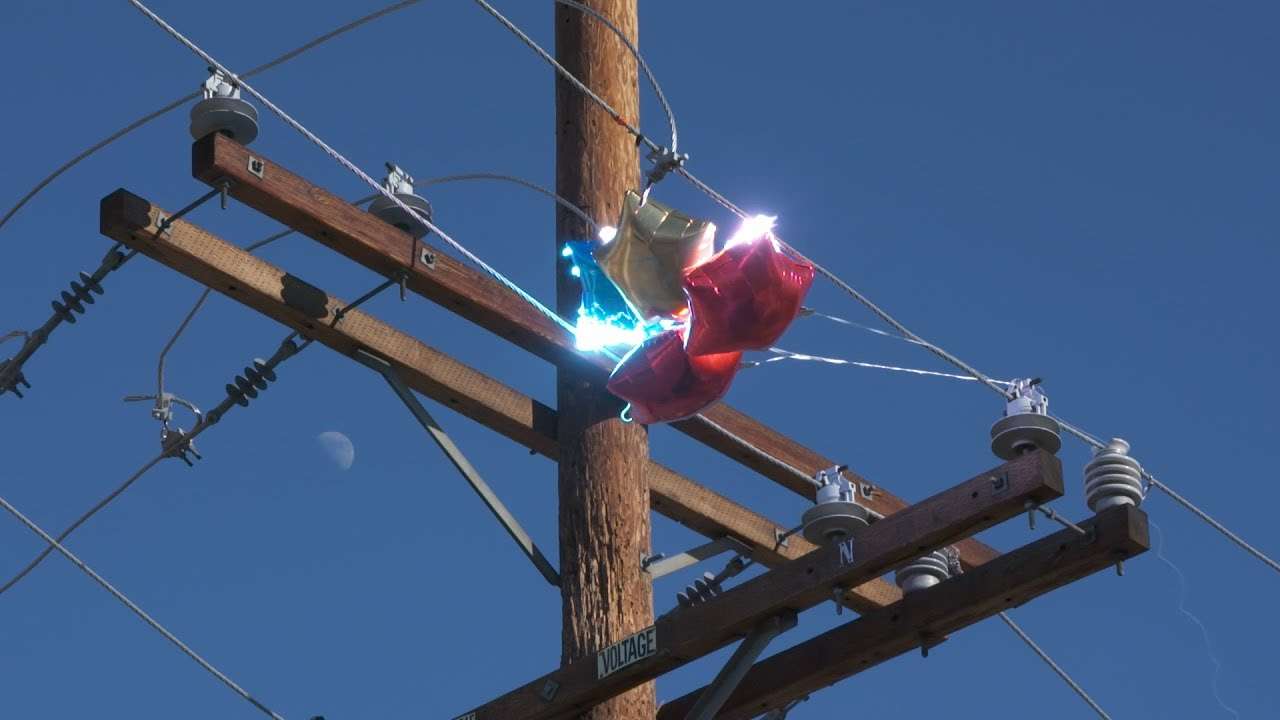
The Danger of Mylar Balloons Near Power Lines: A Growing Concern
Celebrations often involve festive decorations, and among the most popular are mylar balloons. Their shiny, metallic surfaces add a touch of glamour to any event. However, when these seemingly harmless balloons come into contact with power lines, they can create significant hazards. The increasing frequency of power outages caused by mylar balloons is a growing concern for utility companies and communities alike. This article delves into the dangers posed by mylar balloons near power lines, exploring the reasons behind the risks, the consequences of contact, and the steps that can be taken to mitigate these hazards.
Why Mylar Balloons and Power Lines Don’t Mix
Unlike latex balloons, mylar balloons are conductive due to their metallic coating. This conductivity is what makes them such a significant threat when they come into contact with electrical equipment, especially power lines. When a mylar balloon floats into a power line, it can create a short circuit. The metallic surface acts as a conductor, allowing electricity to flow from the power line through the balloon and potentially to the ground or another power line.
The Physics of the Problem
The short circuit caused by a mylar balloon touching a power line can result in a surge of electrical current. This surge can overload the system, causing breakers to trip and power outages to occur. Furthermore, the heat generated by the short circuit can melt the mylar balloon, causing it to cling to the power line. This can create a persistent electrical hazard that requires utility workers to physically remove the balloon, adding to the cost and complexity of the repair.
The Consequences of Mylar Balloon Interference
The consequences of mylar balloon interference with power lines range from minor inconveniences to serious safety risks. Understanding these consequences is crucial for promoting responsible balloon use and preventing future incidents.
Power Outages and Disruptions
The most common consequence of a mylar balloon contacting a power line is a power outage. These outages can affect residential areas, businesses, and critical infrastructure such as hospitals and traffic signals. The duration of the outage can vary depending on the severity of the short circuit and the time it takes for utility crews to locate and repair the damage. Widespread power outages can lead to significant economic losses and disruptions to daily life. [See also: Preventing Electrical Accidents at Home]
Equipment Damage
In addition to causing power outages, mylar balloons can also damage electrical equipment. The surge of electricity from a short circuit can damage transformers, circuit breakers, and other components of the power grid. Replacing or repairing this equipment can be costly and time-consuming, further straining utility resources. The cumulative effect of multiple incidents involving mylar balloons can significantly impact the reliability and efficiency of the power grid.
Safety Hazards
Perhaps the most concerning consequence of mylar balloon interference is the potential for safety hazards. If a mylar balloon comes into contact with a downed power line, it can become energized, posing a risk of electric shock to anyone who touches it. Additionally, the sparks and flames produced by a short circuit can ignite nearby vegetation or structures, leading to fires. It is crucial to treat all downed power lines as if they are live and to maintain a safe distance from them.
Preventative Measures and Best Practices
Preventing mylar balloon-related power outages requires a multi-faceted approach involving public education, responsible balloon handling, and proactive measures by utility companies.
Public Education and Awareness
One of the most effective ways to reduce the risk of mylar balloon interference is to educate the public about the dangers involved. This can be achieved through public service announcements, educational materials distributed by utility companies, and community outreach programs. The message should emphasize the importance of keeping mylar balloons away from power lines and disposing of them properly after use. Informing people about the potential consequences of their actions can encourage them to be more cautious and responsible.
Responsible Balloon Handling
Responsible balloon handling is essential for preventing incidents. This includes keeping mylar balloons tethered at all times, using weights to prevent them from floating away, and properly disposing of them after use. It is also important to avoid releasing mylar balloons outdoors, especially near power lines or other electrical equipment. By taking these simple precautions, individuals can significantly reduce the risk of causing a power outage or other safety hazard.
Utility Company Initiatives
Utility companies can also play a proactive role in preventing mylar balloon interference. This includes conducting regular inspections of power lines to identify potential hazards, trimming trees and vegetation that could come into contact with power lines, and investing in technology that can detect and isolate faults caused by mylar balloons. Some utility companies have also implemented programs to collect and recycle used mylar balloons, further reducing the risk of them ending up near power lines. [See also: Smart Grid Technologies for Power Outage Prevention]
Real-World Examples and Case Studies
Numerous incidents involving mylar balloons and power lines have been documented across the country. These real-world examples highlight the seriousness of the issue and underscore the need for preventative measures.
California Power Outages
California, with its large population and frequent outdoor celebrations, has experienced a high number of power outages caused by mylar balloons. In some cases, entire neighborhoods have been left without power for hours due to a single mylar balloon coming into contact with a power line. These incidents have prompted utility companies in California to launch extensive public awareness campaigns and to work with local communities to promote responsible balloon use.
Texas Case Studies
Texas has also seen its share of mylar balloon-related power outages. One notable case involved a large celebration at a park near a major power substation. Numerous mylar balloons were released during the event, and several of them floated into the substation, causing a significant power outage that affected thousands of residents. This incident led to stricter regulations regarding the use of mylar balloons near critical infrastructure.
The Future of Mylar Balloons and Power Line Safety
As the popularity of mylar balloons continues to grow, it is essential to develop innovative solutions to mitigate the risks they pose to power lines. This includes exploring alternative balloon materials, improving power grid technology, and enhancing public education efforts.
Alternative Balloon Materials
One potential solution is to develop alternative balloon materials that are non-conductive and biodegradable. This would eliminate the risk of short circuits and reduce the environmental impact of balloon debris. Research is currently underway to explore the feasibility of using alternative materials such as plant-based plastics or coated paper for balloon manufacturing. While these materials may not have the same shiny appearance as mylar balloons, they could offer a safer and more sustainable alternative.
Advancements in Power Grid Technology
Another approach is to invest in power grid technology that can better detect and isolate faults caused by mylar balloons. This includes using smart grid technologies that can automatically reroute power around damaged sections of the grid, minimizing the impact of power outages. Additionally, advanced sensors and monitoring systems can be used to detect the presence of mylar balloons near power lines, allowing utility crews to respond quickly and prevent potential incidents.
Continued Public Education
Ultimately, the key to preventing mylar balloon-related power outages is continued public education. By raising awareness about the dangers involved and promoting responsible balloon handling practices, we can create a safer and more reliable power grid for everyone. This requires a collaborative effort involving utility companies, government agencies, community organizations, and individual citizens. Together, we can ensure that celebrations remain festive and safe, without jeopardizing the integrity of our electrical infrastructure.
Conclusion
The seemingly innocent mylar balloon poses a significant threat to power lines and electrical infrastructure. The conductive nature of these balloons, combined with their tendency to float freely, can lead to power outages, equipment damage, and safety hazards. By understanding the risks involved and implementing preventative measures, we can minimize the impact of mylar balloon interference and ensure a more reliable and safe power supply. Public education, responsible balloon handling, and proactive utility company initiatives are all essential components of a comprehensive strategy to address this growing concern. As we continue to celebrate life’s special moments, let us do so responsibly, keeping mylar balloons away from power lines and protecting our communities from the potential consequences.

